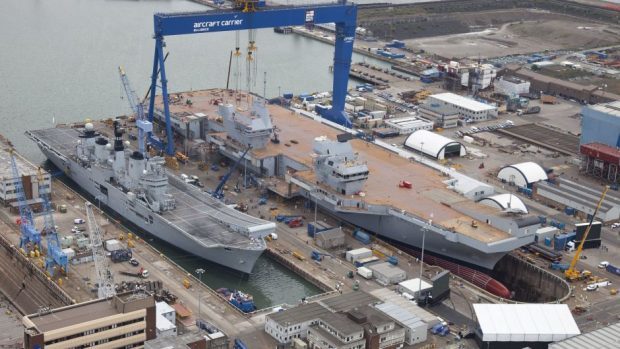The Royal Navy’s largest warship could be heading for the Highlands for her final tests.
The Press and Journal understands that the £3billion HMS Queen Elizabeth will set sail for the Cromarty Firth within months for sea trials.
Longer than the Houses of Parliament and taller than the Niagara Falls, the 65,000-tonne aircraft carrier is currently being completed at the Rosyth shipyard, alongside sister vessel, HMS Prince of Wales.
She will be based at Portsmouth but first has to undergo at least 11 weeks of sea trials.
The Royal Navy would not comment on the location of the sea trials last night, but it is understood that during the period the carrier is due to dock at Invergordon, with tests being carried out in the Moray Firth.
As reported in the UK Defence Journal, Bob Hawkins MBE, first lieutenant of HMS Queen Elizabeth, has written that the trials will comprise “five weeks at sea, one week alongside (Invergordon), five weeks at sea”.
The deep and sheltered waters of the Cromarty Firth are today more closely associated with oil and gas industry platforms, and cruise liners, but were routinely used by the Royal Navy during the world wars.
The aircraft carrier sea trials had been expected to get under way this spring, but defence ministers said last month that they would now be held in the summer.
A spokeswoman for the Aircraft Carriers Alliance – made up of the Ministry of Defence and contractors’ Babcock, BAE Systems and Thales UK – said: “HMS Queen Elizabeth will undertake her maiden sea trials programme in the summer of 2017.
“The QE Class programme represents an engineering challenge of unprecedented scale and complexity for UK shipbuilding.
“HMS Queen Elizabeth is at a mature stage of the testing and commissioning phase, which is designed to thoroughly assess her vast and complex systems and identify any requirements for further work in advance of her maiden sea trials.
“We remain focused on delivering this critical capability for the nation.”
Merlin helicopters will be the first aircraft to begin flying from HMS Queen Elizabeth later this year, soon followed by Apache, Wildcat, Chinook and F-35 fighter jets.
Each of the vessel’s two propellors weigh 33 tonnes, and she will have the ability to travel 500 miles a day.
The construction of the carriers has supported 8,000 jobs around the country, including shipyards in Glasgow, Portsmouth, Birkenhead, Tyne and Devon, with another 3,000 people working in Rosyth, including in supply chain companies.
